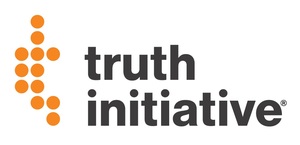Latest Monitoring the Future Survey Reveals Good and Bad News Underscoring Need For Education and Regulation
Cigarette smoking among teens down again with 12th graders below 10% - a milestone event. Vaping on the rise again after last year's decline.
STATEMENT FROM ROBIN KOVAL, CEO AND PRESIDENT OF TRUTH INITIATIVE® ON 2017 MONITORING THE FUTURE SURVEY
WASHINGTON, Dec. 14, 2017 /PRNewswire-USNewswire/ -- Cigarette smoking by teens continued to decline in 2017, according to today's Monitoring the Future survey results. Only 5.4 percent of teenagers in grades eight, 10 and 12 reported smoking a cigarette in the past 30 days, down from 5.9 percent in 2016. This underscores the importance of well-funded and well-executed public education campaigns targeted to today's teens, such as truth®, which prevented more than 300,000 U.S. youth and young adults from becoming smokers during 2015-2016.
Promising data from the report revealed that for the first time ever, past 30-day cigarette prevalence for 12th-grade students is under 10 percent – a milestone achievement. The same age group also saw declines for smokeless, large cigars and hookah use. This progress is another step in the right direction, but is offset by the simultaneous increase in past 30-day use of flavored little cigars and regular little cigars. Easier accessibility and lower prices for little cigars, along with highly appealing fruit and alcoholic beverage flavors such as piña colada, make these products particularly alluring to young people who may not understand that they are as equally harmful as cigarettes.
As it pertains to the acceptability of light or social smoking among young people, it is concerning that harm perceptions of smoking 1-5 cigarettes a day has decreased among 8th and 10th graders. This remains an important education objective as the Surgeon General has stated that there is no safe level of cigarette smoking.
Despite the drop in youth smoking rates, it is disappointing that vaping has increased after a year of decline. The growth and normalization of vaping to consume any substance (nicotine, flavors, or marijuana) is concerning. It is also difficult to interpret the survey data because of inconsistencies year-over-year. Self-reported data on whether a vape product contains nicotine or just flavors is unreliable given that many young people do not purchase their own vape products and, until August 2018, there are no labeling requirements indicating that a product contains nicotine. Data from Nielsen indicate that 99 percent of e-cigarette products sold at monitored U.S. stores in 2015 contain nicotine1. Vaping clouds the picture, literally and figuratively, because young people may not know what they are inhaling. For example, a new, rapidly growing electronic nicotine device called JUUL has become extremely popular among teens. Research from Truth Initiative shows that 25 percent of 15-24-year-old JUUL users do not identify their behavior as vaping, instead referring to it as "JUULing." Furthermore, our research shows that 37 percent of teen and young adult JUUL users are uncertain whether the product contains nicotine when, in fact, all marketed versions of JUUL do contain nicotine.
The likely understatement of nicotine consumption via a vaping device, along with the fact that vaping is being used by 3.6 percent of teens to consume marijuana, is concerning and suggests that vaping is being normalized as a drug delivery system. And, regardless of delivery method, there is simply no place for tobacco, nicotine or other drugs that can impact brain development in the lives of teenagers.
The rise in use of non-traditional tobacco products documented by the survey, as well as increases in little cigar usage among older teens, should be all the motivation the Food and Drug Administration needs to finish the process they started in 2016 and fully regulate all tobacco products on a rapid timetable instead of the current delay that will postpone cigar regulation until 2021 and e-cigarettes until 2022.
The University of Michigan's Monitoring the Future study tracks trends in substance use among students in 12th, 10th and 8th grades. Each year, the national study surveys 40,000 to 50,000 students in about 400 public and private secondary schools throughout the United States.
About Truth Initiative
Truth Initiative is a national public health organization that is inspiring tobacco-free lives and building a culture where all youth and young adults reject tobacco. The truth about tobacco and the tobacco industry are at the heart of our proven-effective and nationally recognized truth® public education campaign, our rigorous and scientific research and policy studies, and our innovative community and youth engagement programs supporting populations at high risk of using tobacco. The Washington, D.C.,-based organization, formerly known as Legacy, was established and funded through the 1998 Master Settlement Agreement between attorneys general from 46 states, five U.S. territories and the tobacco industry. To learn more about how Truth Initiative speaks, seeks and spreads the truth about tobacco, visit truthinitiative.org.
1 Based on unit sales data from January 11, 2015, to December 12, 2015, from The Nielsen Company for convenience stores; supermarkets; mass merchandisers; drug, club, and dollar stores; and Department of Defense commissaries. The data did not include purchases from tobacco specialty shops, "vape shops," or online sources.
SOURCE Truth Initiative
Related Links
WANT YOUR COMPANY'S NEWS FEATURED ON PRNEWSWIRE.COM?
Newsrooms &
Influencers
Digital Media
Outlets
Journalists
Opted In




Share this article